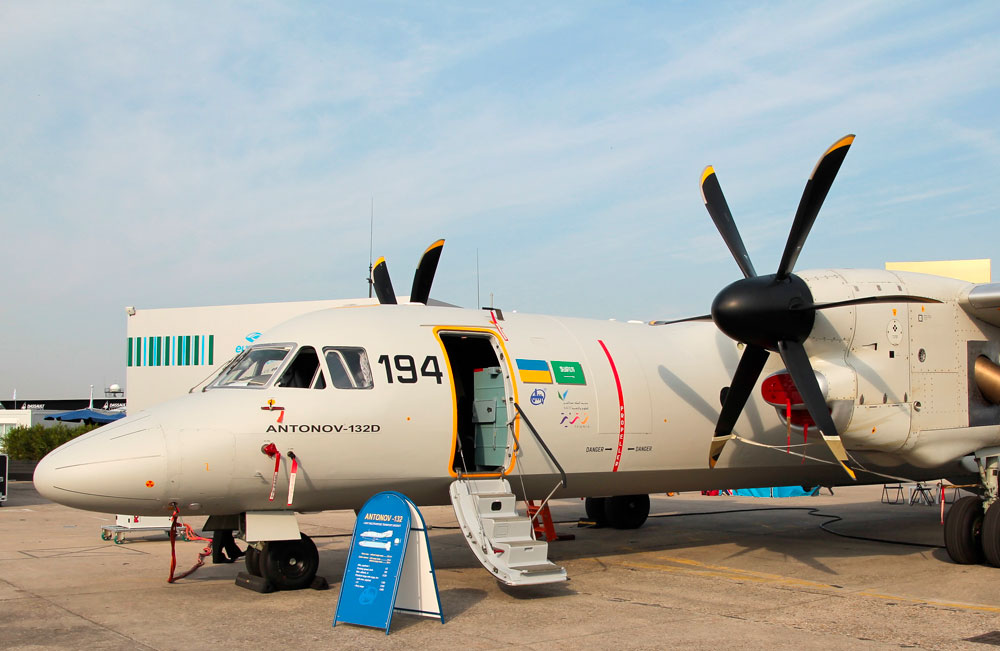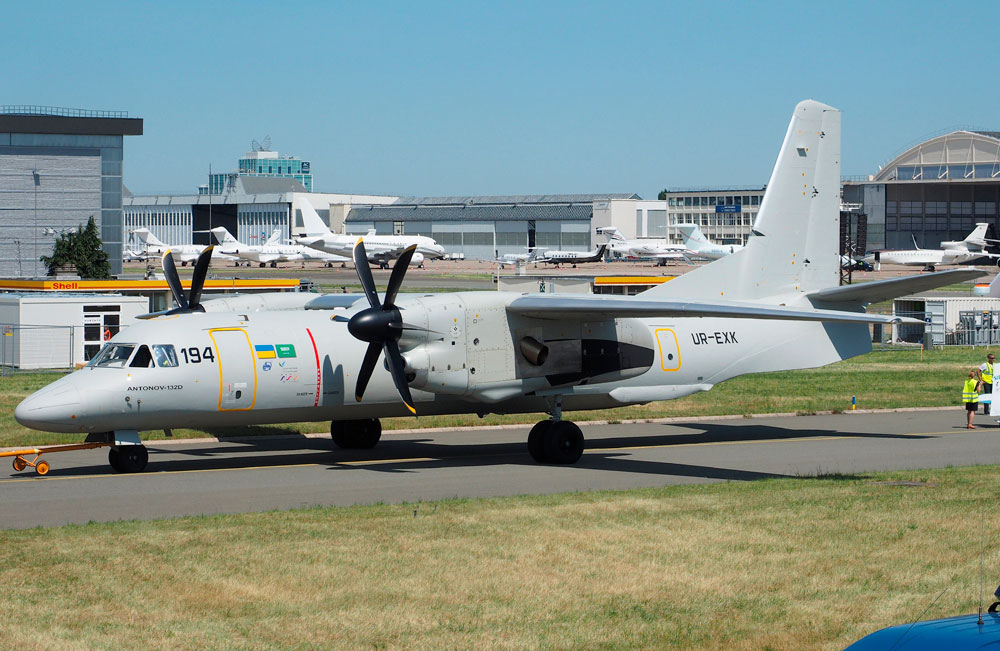The Antonov An-132 is a modernized twin-engine turboprop transport aircraft, developed jointly by Ukraine and Saudi Arabia, designed for short and medium-haul routes.
The Antonov An-132 is a light multipurpose transport aircraft developed by Ukraine’s Antonov State Enterprise in collaboration with Saudi Arabia’s Taqnia Aeronautics. An evolution of the An-32, the An-132 features Western avionics and engines, including two Pratt & Whitney Canada PW150A turboprops. It boasts a maximum payload capacity of 9.2 tonnes and is designed for operations in diverse climates, including hot and high-altitude conditions. The aircraft’s maiden flight occurred on March 31, 2017. Despite its promising design, the project was canceled in April 2019 after the production of a single prototype.
History of Development
In the early 2010s, the need for a modern light transport aircraft became evident, particularly in regions with challenging climates and terrains. The Antonov An-32, known for its robustness in adverse conditions, had been in service since the late 1970s. However, advancements in aviation technology and changing operational requirements necessitated an updated platform.
Recognizing this opportunity, Antonov State Enterprise sought international collaboration to develop a successor to the An-32. In April 2015, Antonov partnered with Saudi Arabia’s Taqnia Aeronautics and King Abdulaziz City for Science and Technology (KACST) to jointly develop the An-132. This partnership aimed to combine Antonov’s design expertise with Saudi investment and market access.
The An-132 was designed to address specific requirements, including enhanced payload capacity, improved fuel efficiency, and the ability to operate in hot and high-altitude environments. The project also sought to reduce reliance on Russian components by incorporating Western engines and avionics.
The development timeline was ambitious. By December 2016, the first prototype, designated An-132D, was rolled out in Kyiv, Ukraine. The aircraft featured significant upgrades over its predecessor, including new engines, avionics, and aerodynamic improvements.
The An-132D conducted its maiden flight on March 31, 2017. The flight lasted approximately 1 hour and 50 minutes, during which the crew assessed the aircraft’s performance and handling characteristics. The successful flight marked a milestone in Ukrainian-Saudi aerospace cooperation.
Despite initial success, the project faced challenges. Plans included establishing production lines in both Ukraine and Saudi Arabia, with the latter aiming to bolster its domestic aerospace industry. However, by April 2019, the project was canceled after producing only one prototype. Factors contributing to the cancellation included financial constraints and shifting strategic priorities.

Design of the Antonov An-132
The An-132 is a twin-engine, high-wing turboprop aircraft designed for versatility in various transport roles. Its design reflects a blend of proven structural concepts and modern technological enhancements.
Dimensions:
- Length: 24.537 meters (80.5 feet)
- Wingspan: 29.2 meters (95.9 feet)
- Height: 8.8 meters (28.9 feet)
The high-wing configuration facilitates better ground clearance and provides stability during low-speed flight, which is advantageous for cargo loading and unloading operations.
Fuselage and Cargo Capacity:
The fuselage is designed to accommodate various cargo types, including palletized goods, military equipment, and personnel. The cargo hold can carry up to 9.2 tonnes (20,300 pounds) of payload. The rear of the fuselage features a ramp, allowing for easy loading and unloading of vehicles and large equipment.
Avionics:
The An-132 is equipped with a modern avionics suite supplied by Honeywell. The cockpit features four large multifunctional LCD screens, providing pilots with critical flight information and system statuses. This advanced avionics system enhances situational awareness and reduces pilot workload.
Engines:
Powering the An-132 are two Pratt & Whitney Canada PW150A turboprop engines, each producing approximately 5,000 horsepower. These engines drive six-bladed composite propellers, offering a balance between performance and fuel efficiency.
Landing Gear:
The aircraft is fitted with a tricycle-type retractable landing gear, designed to operate from various airfield types, including unpaved and semi-prepared runways. This capability is crucial for military and humanitarian missions in remote areas.
Advantages:
- Modernization: Incorporation of Western engines and avionics reduces dependency on Russian components and aligns with international standards.
- Performance: Enhanced payload capacity and fuel efficiency improve operational effectiveness.
- Versatility: Ability to operate in diverse climates and from various airfield types increases mission flexibility.
Drawbacks:
- Development Challenges: The integration of new systems and international collaboration introduced complexities that contributed to project delays and eventual cancellation.
- Market Competition: The aircraft faced competition from established transport aircraft manufacturers, making market penetration challenging.
Performance of the Antonov An-132
The An-132 was designed to deliver robust performance across various operational parameters, making it suitable for both military and civilian applications.
Engine and Power:
The aircraft is powered by two Pratt & Whitney Canada PW150A turbopPerformance of the Antonov An-132 (continued)
Engine and Power:
The Antonov An-132 is powered by two Pratt & Whitney Canada PW150A turboprop engines, each generating approximately 5,000 horsepower. These engines are paired with six-bladed Dowty R408 composite propellers, known for their efficiency and reliability. The powerplants were selected to enhance fuel efficiency and performance in high-temperature and high-altitude conditions, which were critical design requirements for the aircraft.
Speed and Altitude:
The maximum cruising speed of the An-132 is approximately 500 km/h (311 mph), with an operational ceiling of 9,000 meters (29,528 feet). These specifications align with the needs of light transport missions, balancing speed and altitude for efficient short-to-medium range operations.
Range and Payload:
With a maximum payload of 9.2 tonnes (20,300 pounds), the An-132 offers a range of approximately 1,270 nautical miles (2,350 km). When operating with lighter payloads, the aircraft’s range increases, allowing for enhanced mission flexibility. The cargo hold can accommodate a wide variety of loads, including palletized goods, vehicles, and military equipment.
Climatic and Runway Performance:
Designed for operation in extreme climates, the An-132 performs reliably in temperatures ranging from -50°C to +50°C. The aircraft is capable of taking off and landing on semi-prepared or unpaved runways, a critical feature for remote or underdeveloped regions. This adaptability makes it suitable for humanitarian missions, military logistics, and cargo transport in austere environments.
Comparison with Competitors:
When compared to similar light transport aircraft such as the C-27J Spartan and the Alenia G.222, the An-132 holds its ground in payload capacity and operational range. However, the aircraft faced challenges in market competition due to the strong foothold of its rivals, which offered proven operational records and established supply chains. While the An-132 introduced modern Western technology, its relatively short development timeline and limited production impacted its market competitiveness.
Variants of the Antonov An-132
The Antonov An-132 project primarily revolved around its baseline model, but there were conceptual discussions about potential variants to meet diverse market demands.
1. An-132D Prototype:
The An-132D served as the demonstrator and prototype for the aircraft series. It featured all the key design and performance characteristics, including Pratt & Whitney engines and Western avionics.
2. Military Variant:
A proposed military transport variant was intended to include advanced communication systems, reinforced structural components, and provisions for paratroopers and aerial delivery operations. This version would have catered to tactical airlift missions and rapid deployment scenarios.
3. Civilian and Humanitarian Variant:
A civilian transport version was envisioned for cargo and passenger transport in remote areas. Humanitarian organizations also expressed interest in a configuration tailored for disaster relief and medical evacuation, utilizing the aircraft’s unpaved runway capabilities.
These variants, while promising, did not progress beyond the planning stage due to the project’s cancellation.

Military Use and Combat of the Antonov An-132
The Antonov An-132 was not directly developed for combat roles, but its design included features that made it viable for military applications. As a light transport aircraft, the An-132 was well-suited for tactical airlift, logistics support, and reconnaissance missions.
Military Transport Role:
The An-132 was designed to carry troops, equipment, and supplies to remote or hostile environments. Its ability to operate from unprepared airstrips provided tactical flexibility, especially in regions where infrastructure was limited or compromised.
Aerial Delivery and Paratrooper Operations:
With a rear cargo ramp, the An-132 could perform aerial delivery missions for supplies or vehicles. It also had the capability to deploy paratroopers, making it suitable for rapid response scenarios. This feature was particularly attractive to military operators seeking a multi-role transport aircraft.
Reconnaissance and Surveillance:
Although not equipped with dedicated reconnaissance systems, the An-132’s design allowed for potential modifications to include sensors, cameras, and other surveillance equipment. This would have enabled it to perform maritime patrol, border surveillance, and intelligence gathering missions.
Competing Aircraft:
In military applications, the An-132 faced competition from aircraft such as the C-130 Hercules, C-27J Spartan, and CASA C-295. These platforms were well-established, offering proven reliability and extensive global support networks. The An-132’s reliance on Western components was a double-edged sword, as it improved performance but increased costs compared to competitors like the CASA C-295.
International Interest:
Saudi Arabia, as a co-developer, expressed interest in utilizing the An-132 for its military and civilian needs. Discussions also included potential exports to Middle Eastern and African countries, where the aircraft’s operational capabilities could address regional transport challenges. However, the project’s premature termination limited its adoption.
Project Cancellation and Aftermath:
The An-132 did not see widespread military use or participation in combat. Its production was halted after the completion of a single prototype, ending its prospects for operational deployment. The cancellation was attributed to financial constraints and shifting priorities within the collaborating organizations.
The Antonov An-132 represented a bold attempt to modernize light transport aircraft with a focus on versatility, performance, and advanced technology. Its Western components, including Pratt & Whitney engines and Honeywell avionics, marked a departure from traditional Soviet-era designs. Despite its technical promise, the project’s challenges in funding and market competition prevented it from achieving operational success. While the An-132 remains an intriguing chapter in aviation history, its legacy lies in the collaborative efforts between Ukraine and Saudi Arabia to push the boundaries of transport aviation.
Back to Transport planes.